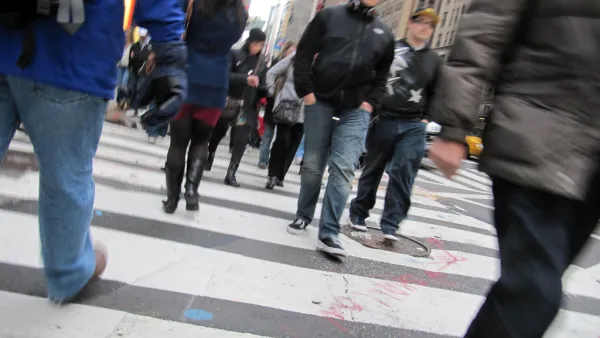In the period since 9/11, Lower Manhattan has undergone a residential boom. With daytime professionals and tourists also in the mix, the strain is showing.

New York City, Manhattan is particular, is growing rapidly. Winnie Hu writes, "By 2000, the city’s population had passed eight million for the first time. Today, it is 8.5 million and counting. By 2040, it is expected to hit nine million, according to city projections."
Despite the damage of September 11, Lower Manhattan has shared in those riches, growing into a residential hub as well as a commercial one. But there is a downside: overcrowding. Said one resident: "We always wished for more restaurants and bars, but what's come with that is trash, noise and congestion. It's one of those double-edged swords."
Part of the story is the disruption that ongoing development causes. "Construction is booming, with 2,465 permits issued for new building projects in 2015, up from 1,517 in 2010, rebounding from an earlier dip during the recession. [...] A labyrinth of imposing metal scaffolding hems in available walkways and forces pedestrians closer together, or into the street."
Trash collection is another problem, as are overcrowded sidewalks. One resident, Hu writes, "used to ride [bikeshare] from her apartment in TriBeCa to her office on Maiden Lane in the financial district nearly every day. But as more pedestrians and cyclists filled the streets, she had to concentrate to avoid running into anyone or being run into."
The area's street layout doesn't help. Lower Manhattan's "residential skyscrapers sit on a colonial-era maze of narrow streets that was not designed for the masses. The city's rectilinear grid above Houston Street allows for better mobility."
FULL STORY: Downside of Lower Manhattan’s Boom: It’s Just Too Crowded

National Parks Layoffs Will Cause Communities to Lose Billions
Thousands of essential park workers were laid off this week, just before the busy spring break season.

Retro-silient?: America’s First “Eco-burb,” The Woodlands Turns 50
A master-planned community north of Houston offers lessons on green infrastructure and resilient design, but falls short of its founder’s lofty affordability and walkability goals.

Delivering for America Plan Will Downgrade Mail Service in at Least 49.5 Percent of Zip Codes
Republican and Democrat lawmakers criticize the plan for its disproportionate negative impact on rural communities.

Test News Post 1
This is a summary

Test News Headline 46
Test for the image on the front page.

Balancing Bombs and Butterflies: How the National Guard Protects a Rare Species
The National Guard at Fort Indiantown Gap uses GIS technology and land management strategies to balance military training with conservation efforts, ensuring the survival of the rare eastern regal fritillary butterfly.
Urban Design for Planners 1: Software Tools
This six-course series explores essential urban design concepts using open source software and equips planners with the tools they need to participate fully in the urban design process.
Planning for Universal Design
Learn the tools for implementing Universal Design in planning regulations.
EMC Planning Group, Inc.
Planetizen
Planetizen
Mpact (formerly Rail~Volution)
Great Falls Development Authority, Inc.
HUDs Office of Policy Development and Research
NYU Wagner Graduate School of Public Service





























